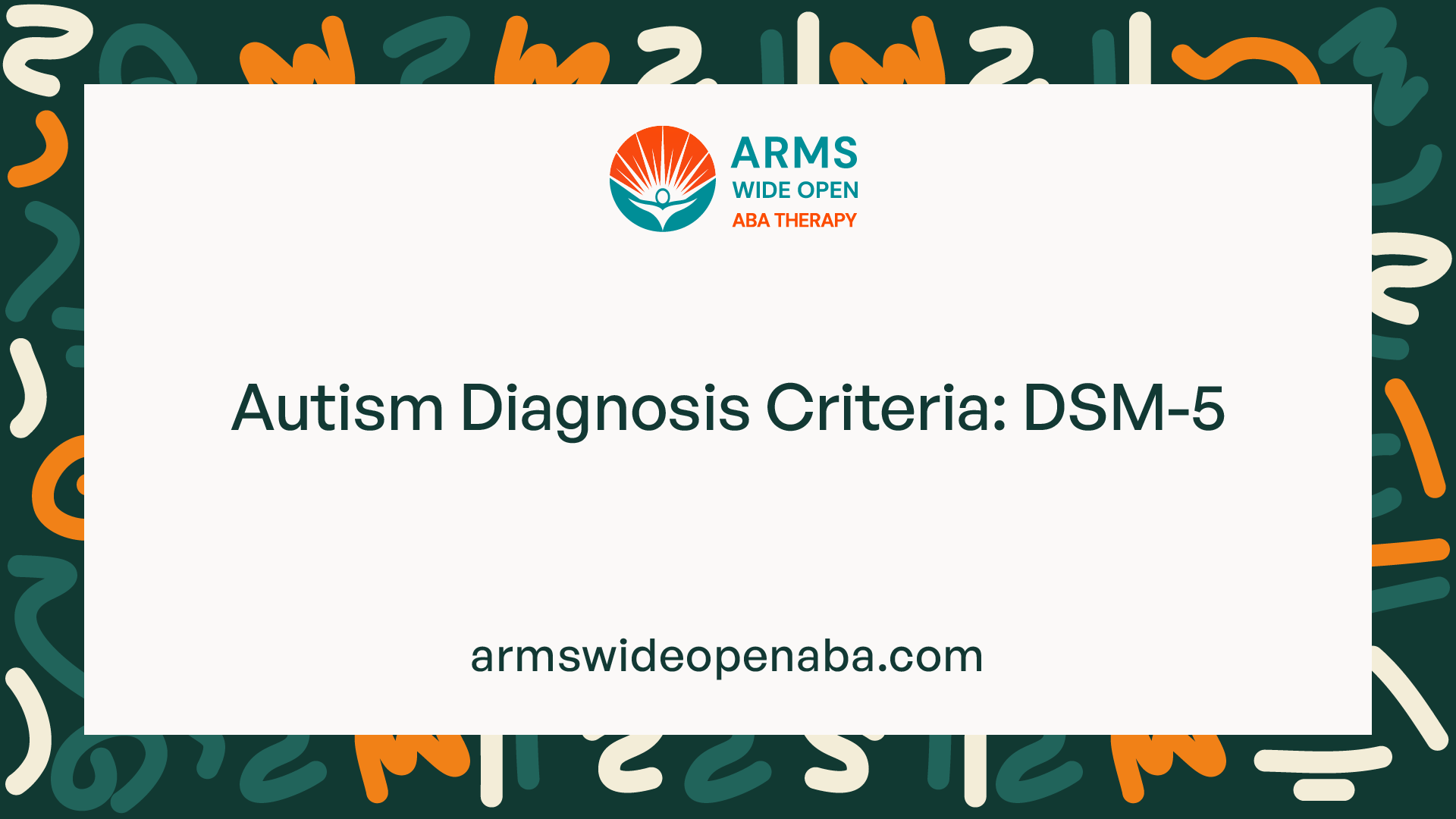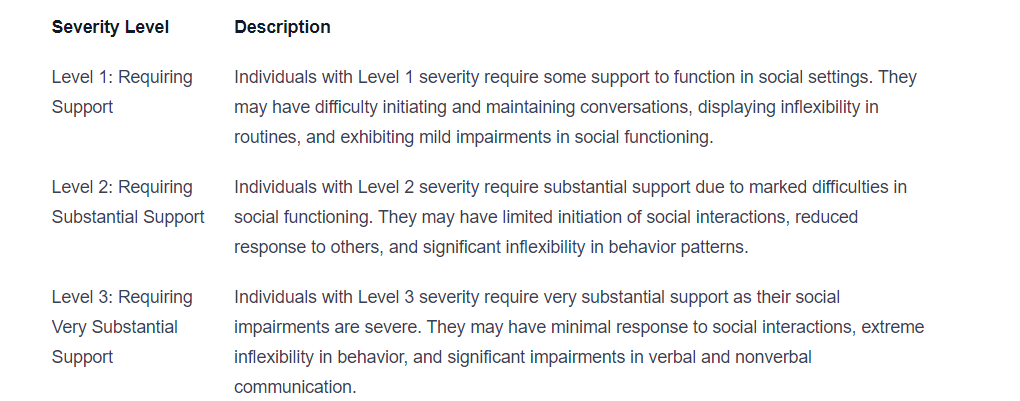Autism Diagnosis Criteria: DSM-5
Unlock the secrets of autism diagnosis criteria in DSM-5. Gain insight into social communication, behaviors, and more. Explore now!
.jpeg)
Understanding Autism Spectrum Disorder (ASD)
To comprehend the diagnosis criteria for autism spectrum disorder (ASD) as outlined in the DSM-5, it is essential to first understand what ASD is and the significance of an accurate diagnosis.

What is Autism Spectrum Disorder?
Autism Spectrum Disorder (ASD) is a neurodevelopmental disorder that affects social communication, behavior, and sensory processing. It is characterized by a wide range of symptoms and varying degrees of impairment. Individuals with ASD may experience challenges in social interaction, communication, and exhibit repetitive behaviors or restricted interests.
ASD is a spectrum disorder, which means that it manifests differently in each individual. Some individuals may have mild symptoms and be highly functional, while others may have more severe impairments that require significant support.
Importance of Accurate Diagnosis
Accurate diagnosis of ASD is crucial for several reasons. First and foremost, it helps individuals and their families gain a better understanding of the challenges they may be facing and access appropriate support and interventions. Early diagnosis allows for early intervention, which can significantly improve outcomes for individuals with ASD.
Furthermore, an accurate diagnosis enables healthcare professionals, educators, and therapists to tailor their interventions and strategies to meet the specific needs of individuals with ASD. It also facilitates access to specialized services, accommodations, and resources that can enhance the individual's quality of life and well-being.
By diagnosing ASD based on standardized criteria, such as those outlined in the DSM-5, professionals can ensure consistency and reliability in the diagnosis process. This helps to reduce misdiagnosis and ensures that individuals receive the appropriate support and services.
Understanding what ASD is and the importance of an accurate diagnosis sets the foundation for exploring the diagnostic criteria outlined in the DSM-5. Through a comprehensive understanding of these criteria, healthcare professionals can effectively identify and diagnose individuals with ASD, leading to improved support and outcomes for those on the autism spectrum.
Diagnostic and Statistical Manual of Mental Disorders (DSM-5)
The Diagnostic and Statistical Manual of Mental Disorders, Fifth Edition (DSM-5), is a widely recognized and authoritative guide used by healthcare professionals to diagnose various mental health conditions, including Autism Spectrum Disorder (ASD). Understanding the DSM-5 is crucial in comprehending the criteria used to diagnose autism.
Overview of DSM-5
The DSM-5 is a comprehensive manual developed by the American Psychiatric Association (APA) that provides a standardized framework for diagnosing mental disorders. It offers clear diagnostic criteria, symptom descriptions, and guidelines for healthcare professionals to facilitate accurate diagnoses.
This manual serves as a valuable resource for clinicians, researchers, and educators involved in the assessment and treatment of autism and other mental health conditions. It undergoes periodic revisions to incorporate the latest research findings and clinical knowledge, ensuring that it remains up to date and relevant.
Autism Diagnosis Criteria in DSM-5
The DSM-5 introduced significant changes to the diagnostic criteria for Autism Spectrum Disorder, refining and expanding upon the previous edition. The diagnostic criteria are divided into two main categories: social communication and interaction, and restricted and repetitive behaviors.
To receive a diagnosis of Autism Spectrum Disorder according to the DSM-5, an individual must display persistent deficits in social communication and interaction across multiple contexts, as well as restricted and repetitive patterns of behavior, interests, or activities.
These criteria provide a standardized framework for healthcare professionals to assess individuals for autism. The DSM-5 emphasizes the importance of evaluating the severity levels of these symptoms, allowing for a more comprehensive understanding of an individual's unique presentation of autism.
By utilizing the criteria outlined in the DSM-5, healthcare professionals can accurately diagnose Autism Spectrum Disorder and provide appropriate interventions and support for individuals on the autism spectrum.
Please note that the DSM-5 is a tool for professionals and should not be used as a self-diagnostic tool. Only qualified healthcare professionals can make an accurate diagnosis based on a comprehensive evaluation of an individual's symptoms and history.
The Core Symptoms of Autism
To understand the diagnosis criteria for Autism Spectrum Disorder (ASD) in the DSM-5, it's important to familiarize ourselves with the core symptoms of autism. These symptoms are categorized into two main areas: social communication and interaction, and restricted and repetitive behaviors.
Social Communication and Interaction
Individuals with autism often experience challenges in social communication and interaction. They may have difficulty understanding and using verbal and nonverbal communication cues, making it challenging to engage in meaningful social interactions. Some common symptoms include:
- Impairments in social-emotional reciprocity: This refers to difficulties in initiating and responding to social interactions. Individuals with autism may struggle with reciprocal conversation, sharing interests, or emotions with others.
- Deficits in nonverbal communicative behaviors: People with autism may have difficulty understanding and using nonverbal communication, such as gestures, facial expressions, and body language. This can make it challenging for them to interpret social cues and understand the perspectives of others.
- Difficulties in developing and maintaining relationships: Establishing and maintaining relationships can be challenging for individuals with autism. They may struggle with forming and sustaining friendships, and may have limited interest in socializing or engaging in age-appropriate social activities.
Restricted and Repetitive Behaviors
Another core feature of autism is the presence of restricted and repetitive behaviors. These behaviors often manifest as repetitive movements, inflexible adherence to routines, and intense focus on specific interests or topics. Some common examples include:
- Stereotyped or repetitive motor movements: People with autism may engage in repetitive behaviors such as hand-flapping, rocking, or spinning. These behaviors can serve as self-soothing mechanisms or ways to cope with sensory overload.
- Insistence on sameness and resistance to change: Individuals with autism often prefer predictability and routine. They may become upset or distressed when there are changes in their daily schedules or when asked to deviate from established routines.
- Restricted interests with intense focus: People with autism may develop intense interests in specific topics or objects. They may spend significant amounts of time learning, discussing, or engaging in activities related to their interests, often at the expense of other activities.
Understanding these core symptoms of autism is essential for accurate diagnosis and identification of individuals who may benefit from interventions and support. By recognizing and assessing the presence of social communication and interaction difficulties, as well as restricted and repetitive behaviors, healthcare professionals can make informed decisions in accordance with the diagnostic criteria outlined in the DSM-5.
Diagnostic Criteria for ASD in DSM-5
When it comes to diagnosing Autism Spectrum Disorder (ASD), the Diagnostic and Statistical Manual of Mental Disorders (DSM-5) provides specific criteria that clinicians use to assess individuals for an accurate diagnosis. These criteria are divided into two main categories: social communication and interaction, and restricted and repetitive behaviors.
Criteria for Social Communication and Interaction
The DSM-5 outlines several criteria related to social communication and interaction that are taken into consideration during the diagnosis of ASD. These criteria include challenges in social-emotional reciprocity, deficits in nonverbal communicative behaviors, and difficulties in developing and maintaining relationships.
To meet the criteria for social communication and interaction, an individual must display persistent deficits in these areas, which may manifest as challenges in initiating and responding to social interactions, limited eye contact, difficulties in understanding and using nonverbal communication, and struggles in developing and maintaining friendships.
Criteria for Restricted and Repetitive Behaviors
Another set of criteria outlined in the DSM-5 focuses on restricted and repetitive behaviors, which are common characteristics of individuals with ASD. These behaviors encompass a wide range of repetitive patterns of behavior, interests, or activities. The criteria include stereotyped or repetitive motor movements, insistence on sameness, inflexible adherence to routines, highly restricted interests, and hyper- or hypo-reactivity to sensory input.
To meet the criteria for restricted and repetitive behaviors, an individual must display at least two of these behaviors, which are present in a persistent and repetitive manner. These behaviors can significantly impact various aspects of an individual's life, including their daily routines, social interactions, and overall functioning.
It's important to note that the severity and impact of these criteria may vary from person to person. The DSM-5 also includes different severity levels to provide a comprehensive understanding of an individual's presentation of ASD. These severity levels range from Level 1 (requiring support) to Level 3 (requiring very substantial support).
By utilizing the diagnostic criteria outlined in the DSM-5, clinicians can assess individuals and determine whether they meet the criteria for an Autism Spectrum Disorder diagnosis. These criteria help ensure a standardized and accurate diagnosis, enabling individuals to access appropriate support, interventions, and resources tailored to their specific needs.
Additional Considerations in Autism Diagnosis
While the diagnostic criteria outlined in the DSM-5 form the foundation for an autism spectrum disorder (ASD) diagnosis, there are additional considerations that play a role in the assessment process. Understanding the severity levels in DSM-5 and considering differential diagnosis and comorbidities are crucial for a comprehensive evaluation.
Severity Levels in DSM-5
The DSM-5 introduces severity levels to provide a framework for assessing the impact of autism symptoms on an individual's daily functioning. These levels are based on the level of support required and the severity of symptoms in two key areas: social communication and interaction, and restricted and repetitive behaviors.
The severity levels are categorized as follows:

The severity levels assist in understanding the varying degrees of impairment and tailoring interventions and support accordingly.
Differential Diagnosis and Comorbidities
Diagnosing autism spectrum disorder involves differentiating it from other conditions with similar symptoms. This process, known as differential diagnosis, is essential for accurate identification and appropriate treatment planning. Conditions that may have overlapping features with autism include intellectual disability, language disorders, ADHD, anxiety disorders, and others.
To ensure a comprehensive evaluation, healthcare professionals consider a range of factors, such as the individual's developmental history, observed behaviors, and standardized assessment tools. Collaboration among professionals from various disciplines, including psychologists, psychiatrists, speech-language pathologists, and occupational therapists, is often necessary to arrive at an accurate diagnosis.
Additionally, comorbidities, or the presence of other conditions alongside autism, are common. These can include conditions like epilepsy, sleep disorders, gastrointestinal issues, and mental health disorders. Identifying and addressing comorbidities is crucial for providing holistic care to individuals with autism.
By considering severity levels and conducting a thorough differential diagnosis, healthcare professionals can ensure accurate and comprehensive evaluations for autism spectrum disorder. This leads to effective intervention strategies and support for individuals with autism and their families.
Sources
https://www.autismspeaks.org/autism-diagnosis-criteria-dsm-5
https://theplaceforchildrenwithautism.com/diagnosing-autism/the-three-levels-of-autism
https://www.medicalnewstoday.com/articles/325106
Similar articles
We’re here to help you

Our team is here to assist you in this process. Contact us for any assistance.
it’s easy to apply
We Accept Most Insurances
Our in-network insurance partnerships make ABA therapy more accessible to families throughout our service areas.







Our Insurance Process
We'll request your insurance details to help us verify your plan's coverage for ABA therapy. Once we've received this information, we'll walk you through your benefits, including copayments, deductibles and out-of-pocket maximums, so you know what to expect in advance.
Our team will then handle the preauthorization and all the necessary paperwork.
.svg)





















.jpeg)


































.jpeg)




.jpeg)







.jpeg)











.jpeg)
















